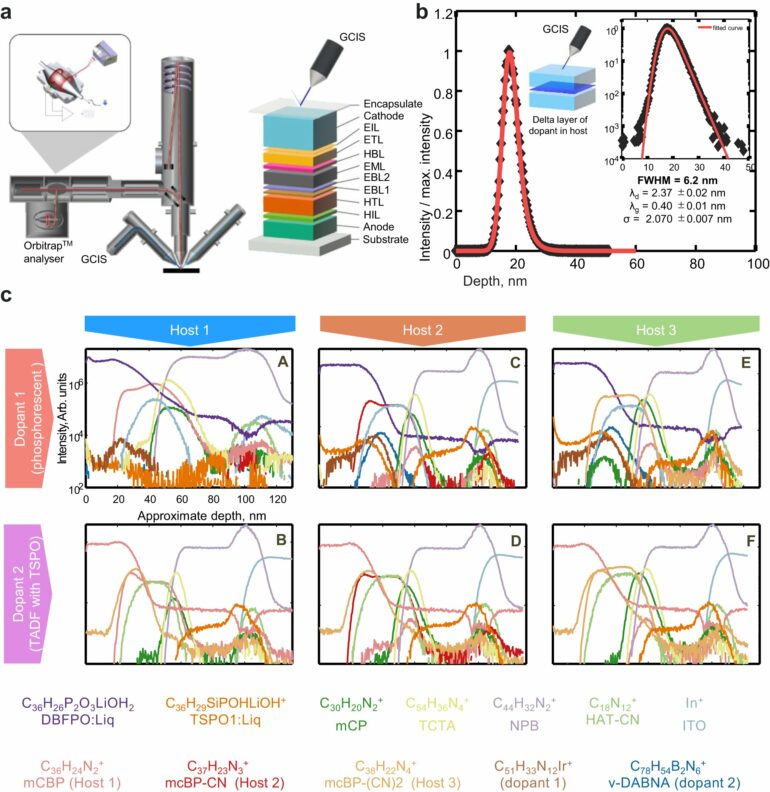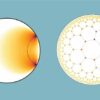Scientists at the National Physical Laboratory (NPL) have collaborated with the Samsung Advanced Institute of Technology (SAIT) on a new study to better understand the degradation of blue organic light-emitting diodes (OLEDs). The study has been published in Nature Communications.
The degradation mechanisms—whether physical, chemical or something else—that cause blue OLEDs to fail are still not yet fully understood. This limits the stability of blue OLEDs—and by extension the lifetime of OLED technology in full color display screens and lighting.
The first polymer light-emitting diode (PLED) was created at NPL in 1975. It used a polymer film of up to 2.2 micrometers thick located between two charge-injecting electrodes. Since then, developments in red and green OLED technology resulted in these colored OLEDs being now comparable to conventional LEDs.
Understanding the degradation mechanism of blue OLEDs is essential to improve their performance and stability. However, OLEDs are formed of very thin layers of organic molecules, and chemically sampling nanoscale organic layers and interfaces with enough analytical information is challenging.
To tackle this longstanding problem, the NPL / SAIT team used OrbiSIMS, an innovative mass spectrometry imaging technique invented at NPL in 2017. The team used OrbiSIMS’ nanoscale mass spectrometry to identify, for the first time, degradation molecules of blue OLEDs with unprecedented sensitivity and localize them with seven nanometers depth resolution within the OLEDs multi-layered architecture.
The team found that chemical degradation is mainly related to loss of oxygen in molecules at the interface between emission and electron transport layers. The OrbiSIMS results also showed approximately one order of magnitude increase in the lifetime of OLED devices that use slightly different host materials.
The results and the method described in the study can inform and drive future efforts to improve the performance of new blue OLED architectures and help display technology manufacturers develop better quality displays with longer product lifetimes. The method has already been used in another study led by Samsung and the Korea Advanced Institute of Science & Technology (KAIST), which was also published in Nature Communications.
Dr. Gustavo Trindade, one of NPL lead authors of the study said, “Our research—which was selected as an Editor choice within the theme ‘devices’—enabled us to identify degradation molecules that are reaction products localized at the interface between emission and electron transport layers (ETL/EML).”
“The presence of these degradation molecules correlates negatively with the blue OLEDs lifetime. Furthermore, we showed that devices with subtly modified host materials have much reduced intensities of the interfacial degradation products and exhibit superior lifetime.”
Professor Ian Gilmore, NPL corresponding author of the study said, “OrbiSIMS allows high confidence in the identification of complex molecules with attomole sensitivity and simultaneous localization to a layer of less than seven nanometers. This cannot be achieved using traditional High-performance LC-MS methods requiring dissolution of the device. OrbiSIMS as a diagnostic tool for degradation of OLEDs can play a vital role in providing insight for future material and device architecture development.”
Dr. Soohwan Sul and Dr. Joonghyuk Kim, SAIT lead authors of the study said, “We were delighted to work with Professor Ian Gilmore’s NPL team to apply the OrbiSIMS for the first time to study the degradation of organic light emitting diodes (OLED), which is currently one of major obstacles for the OLED industry.”
“Thanks to the development of the OrbiSIMS with its unprecedented depth/mass resolution and the ability of the intact analysis of organic molecules, we can now diagnose and answer a variety of outstanding problems in organic electronic devices such as OLEDs.”
More information:
Gustavo F. Trindade et al, Direct identification of interfacial degradation in blue OLEDs using nanoscale chemical depth profiling, Nature Communications (2023). DOI: 10.1038/s41467-023-43840-9
Provided by
National Physical Laboratory
Citation:
Collaborating scientists offer insights on improving blue OLED performance for displays and lighting (2024, February 26)



